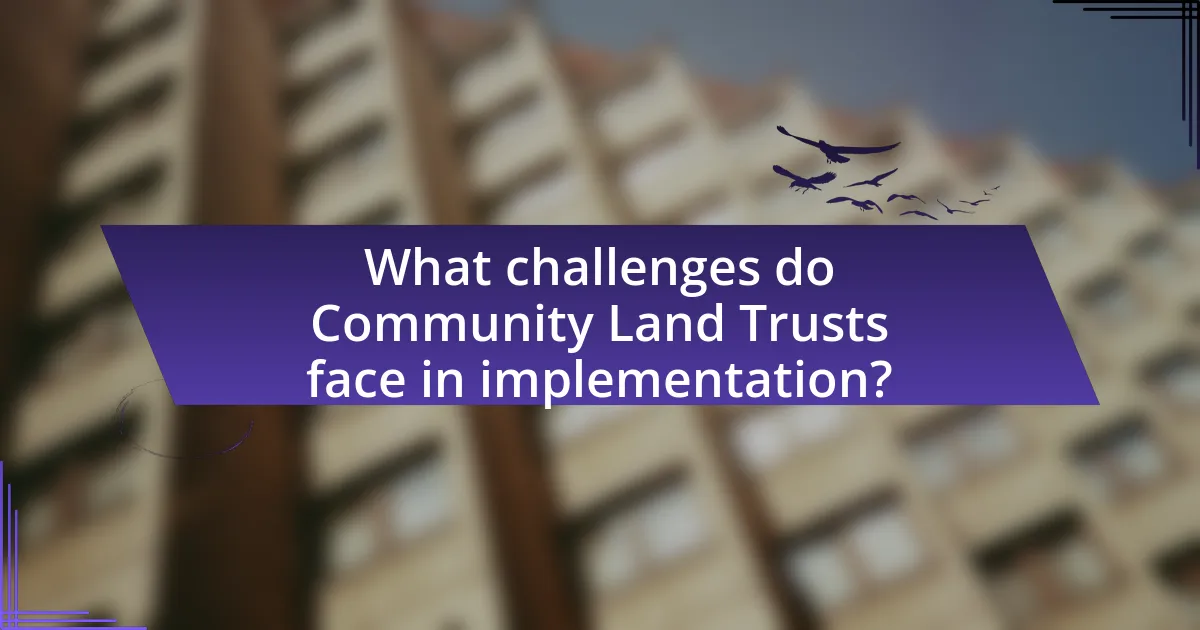Community Land Trusts (CLTs) are nonprofit organizations that acquire and manage land to provide affordable housing and promote community development. This article explores the operational mechanisms of CLTs, highlighting their role in maintaining long-term affordability by separating land ownership from housing ownership. It discusses the key components of CLTs, their differences from traditional housing models, and the specific challenges they address in the affordable housing sector. Additionally, the article examines the financing mechanisms utilized by CLTs, the impact of community engagement, and the future prospects for CLTs as a sustainable solution to the growing housing crisis.

What are Community Land Trusts and their role in affordable housing?
Community Land Trusts (CLTs) are nonprofit organizations that acquire and hold land to provide affordable housing and promote community development. CLTs play a crucial role in affordable housing by ensuring that homes remain affordable for low- and moderate-income families, even as property values increase. This is achieved through a model where the CLT retains ownership of the land while selling or leasing the homes on it, which allows for long-term affordability and community control over land use. According to the Lincoln Institute of Land Policy, CLTs have successfully created over 15,000 affordable homes in the United States, demonstrating their effectiveness in addressing housing needs.
How do Community Land Trusts operate?
Community Land Trusts (CLTs) operate by acquiring and holding land to provide affordable housing and community development. They separate land ownership from housing ownership, allowing CLTs to maintain long-term affordability by leasing land to homeowners at below-market rates. This model enables residents to build equity in their homes while ensuring that the land remains affordable for future generations. CLTs often involve community members in decision-making processes, fostering local engagement and investment in the neighborhood. Studies show that CLTs can effectively stabilize communities and prevent displacement, as evidenced by successful initiatives in cities like Burlington, Vermont, where the CLT model has preserved over 200 affordable homes since its inception in 1984.
What are the key components of a Community Land Trust?
The key components of a Community Land Trust (CLT) include community ownership of land, long-term affordability, and stewardship of land and housing. Community ownership ensures that the land is held in trust for the benefit of the community, preventing speculation and displacement. Long-term affordability is achieved through mechanisms like resale restrictions, which keep housing prices accessible for future buyers. Stewardship involves the CLT managing the land and properties to maintain quality and support residents, often providing resources for home maintenance and community development. These components work together to create sustainable and equitable housing solutions.
How do Community Land Trusts differ from traditional housing models?
Community Land Trusts (CLTs) differ from traditional housing models primarily in their ownership structure and purpose. CLTs are nonprofit organizations that acquire and hold land to provide affordable housing, ensuring long-term affordability for residents by separating land ownership from housing ownership. This model allows for reduced housing costs, as residents purchase homes at below-market prices while the CLT retains ownership of the land, which is often held in trust for community benefit. In contrast, traditional housing models typically involve private ownership of both land and housing, leading to market-driven price fluctuations and potential displacement of low-income residents. Studies have shown that CLTs can stabilize neighborhoods and promote equitable access to housing, as evidenced by the success of CLTs in cities like Burlington, Vermont, where homeownership rates among low-income families increased significantly due to this model.
Why are Community Land Trusts considered a solution for affordable housing?
Community Land Trusts (CLTs) are considered a solution for affordable housing because they remove land from the speculative market, ensuring long-term affordability for residents. By acquiring and holding land in trust, CLTs enable the construction of homes that remain affordable for low- and moderate-income families, even as property values rise. Research indicates that CLTs can maintain affordability through mechanisms like ground leases, which separate the ownership of land from the ownership of housing, thereby stabilizing costs. For example, a study by the Lincoln Institute of Land Policy found that CLTs can effectively preserve affordability over time, with some properties remaining affordable for over 30 years. This model not only addresses immediate housing needs but also fosters community stability and resilience.
What specific challenges in affordable housing do Community Land Trusts address?
Community Land Trusts (CLTs) address several specific challenges in affordable housing, including rising land costs, housing instability, and the preservation of long-term affordability. By acquiring and holding land in trust, CLTs remove it from the speculative market, which helps to stabilize housing prices and make homeownership accessible to low- and moderate-income families. Additionally, CLTs often implement policies that ensure homes remain affordable for future buyers, thereby combating displacement and promoting community stability. Research indicates that CLTs can effectively reduce the cost burden on residents, as evidenced by the success of various CLTs across the United States, which have demonstrated the ability to maintain affordability over decades.
How do Community Land Trusts promote long-term affordability?
Community Land Trusts (CLTs) promote long-term affordability by separating land ownership from housing ownership, which stabilizes housing costs. This model allows CLTs to maintain control over the land, ensuring that homes built on it remain affordable for future generations. By implementing resale restrictions and limiting profit on home sales, CLTs prevent market speculation and keep housing prices aligned with local income levels. For instance, a study by the Lincoln Institute of Land Policy found that homes in CLTs appreciate at a slower rate than market homes, which helps maintain affordability over time.

What financing mechanisms are utilized by Community Land Trusts?
Community Land Trusts (CLTs) utilize various financing mechanisms, including grants, public funding, private donations, and loans. Grants from government agencies and philanthropic organizations provide initial capital for land acquisition and development. Public funding, such as low-income housing tax credits and community development block grants, supports affordable housing projects. Private donations from individuals and businesses can also contribute to CLT funding. Additionally, CLTs often secure loans from banks or credit unions, which are repaid through the sale of homes or rental income, ensuring sustainability and ongoing affordability. These mechanisms collectively enable CLTs to acquire and maintain land for affordable housing, addressing community needs effectively.
How do Community Land Trusts secure funding?
Community Land Trusts secure funding through a combination of public and private sources, including government grants, philanthropic contributions, and financing from banks and credit unions. These funding mechanisms enable Community Land Trusts to acquire and develop land for affordable housing projects. For instance, the U.S. Department of Housing and Urban Development (HUD) provides grants specifically for community development initiatives, which can be utilized by Community Land Trusts to support their operations and projects. Additionally, many Community Land Trusts engage in fundraising efforts and partnerships with local organizations to enhance their financial resources, ensuring sustainable funding for their mission of providing affordable housing.
What role do grants and donations play in financing Community Land Trusts?
Grants and donations are crucial for financing Community Land Trusts (CLTs) as they provide essential funding for land acquisition, development, and operational costs. These financial contributions enable CLTs to secure land for affordable housing, which is often unaffordable through traditional financing methods. For instance, according to the National Community Land Trust Network, CLTs rely heavily on grants from government agencies and philanthropic organizations to cover initial costs and sustain their operations, allowing them to maintain long-term affordability for residents.
How can public-private partnerships enhance funding for Community Land Trusts?
Public-private partnerships can enhance funding for Community Land Trusts by leveraging resources and expertise from both sectors to create sustainable financial models. These partnerships allow for the pooling of public funds, such as government grants and subsidies, alongside private investments, which can include philanthropic contributions and financing from private developers. For instance, a study by the Lincoln Institute of Land Policy highlights that successful public-private partnerships have led to increased capital for affordable housing initiatives, demonstrating that collaborative funding strategies can effectively address housing shortages. By combining the strengths of public oversight and private efficiency, these partnerships can provide a more robust financial foundation for Community Land Trusts, ultimately facilitating the development of affordable housing solutions.
What are the financial benefits of Community Land Trusts for communities?
Community Land Trusts (CLTs) provide significant financial benefits for communities by stabilizing housing costs and promoting long-term affordability. CLTs achieve this by acquiring land and ensuring that it remains affordable for low- and moderate-income residents, which helps to prevent displacement and gentrification. For instance, studies have shown that homes within CLTs can be sold at prices significantly lower than the market rate, often by 20% to 50%, making homeownership accessible to more families. Additionally, CLTs can leverage public and private funding, enhancing community investment and fostering economic development. This model not only preserves affordability but also generates local jobs and increases property tax revenues, contributing to the overall financial health of the community.
How do Community Land Trusts contribute to local economic development?
Community Land Trusts (CLTs) contribute to local economic development by promoting affordable housing, which stabilizes neighborhoods and enhances local economies. By acquiring and holding land for community benefit, CLTs ensure that housing remains affordable, preventing displacement and fostering diverse, sustainable communities. Research indicates that CLTs can increase property values in surrounding areas while maintaining affordability, as seen in studies conducted by the Lincoln Institute of Land Policy, which found that CLTs often lead to increased homeownership rates and local investment. Additionally, CLTs can create jobs through construction and maintenance of affordable housing, further stimulating local economic activity.
What impact do Community Land Trusts have on property values?
Community Land Trusts (CLTs) generally stabilize or reduce property values in their targeted areas. This occurs because CLTs remove land from the speculative market, ensuring that housing remains affordable for low- and moderate-income families. Research indicates that properties within CLT boundaries often experience less volatility in value compared to surrounding areas, as the focus on affordability limits price increases. For instance, a study by the Lincoln Institute of Land Policy found that homes in CLTs appreciated at a slower rate than conventional homes, which helps maintain long-term affordability and community stability.

What challenges do Community Land Trusts face in implementation?
Community Land Trusts (CLTs) face several challenges in implementation, including securing adequate funding, navigating complex regulatory environments, and building community support. Funding is often limited, as CLTs rely on a mix of public and private sources, which can be inconsistent and insufficient to meet their needs. Regulatory hurdles can arise from zoning laws and land use policies that may not align with CLT objectives, complicating the development process. Additionally, gaining community support is crucial; without it, CLTs may struggle to establish trust and engagement, which are essential for their long-term success. These challenges can hinder the effectiveness of CLTs as a viable solution for affordable housing.
What legal and regulatory hurdles must Community Land Trusts navigate?
Community Land Trusts (CLTs) must navigate various legal and regulatory hurdles, including zoning laws, land use regulations, and compliance with federal and state housing policies. Zoning laws can restrict the types of housing that can be developed on CLT-owned land, impacting their ability to provide affordable housing. Additionally, land use regulations may impose requirements that complicate the development process, such as environmental assessments or infrastructure improvements. Compliance with federal and state housing policies, including the Fair Housing Act and local housing codes, is essential to ensure that CLTs operate within legal frameworks and secure funding. These hurdles can significantly affect the operational capacity and effectiveness of CLTs in addressing affordable housing needs.
How can zoning laws affect the establishment of Community Land Trusts?
Zoning laws can significantly influence the establishment of Community Land Trusts (CLTs) by dictating land use, density, and development standards. These regulations can either facilitate or hinder the ability of CLTs to acquire and develop land for affordable housing. For instance, permissive zoning that allows for mixed-use development can enable CLTs to create diverse housing options, while restrictive zoning can limit their capacity to build or rehabilitate properties. Additionally, zoning laws that prioritize affordable housing can provide incentives or streamline processes for CLTs, enhancing their effectiveness in addressing housing needs. Conversely, stringent zoning regulations may create barriers, making it challenging for CLTs to operate effectively in certain areas.
What are the common misconceptions about Community Land Trusts?
Common misconceptions about Community Land Trusts (CLTs) include the belief that they are only for low-income individuals, that they limit property rights excessively, and that they are not sustainable long-term solutions for housing. CLTs actually serve a diverse range of income levels, allowing for mixed-income communities. Additionally, while CLTs do impose certain restrictions to maintain affordability, they do not eliminate property rights; homeowners retain equity and can sell their homes under agreed-upon terms. Research indicates that CLTs can provide stable, affordable housing options over decades, demonstrating their sustainability and effectiveness in addressing housing needs.
How can communities effectively establish and manage Community Land Trusts?
Communities can effectively establish and manage Community Land Trusts (CLTs) by forming a dedicated organization that involves local stakeholders, securing funding, and implementing governance structures. Establishing a CLT begins with community engagement to identify housing needs and gather support, which can be facilitated through workshops and meetings. Securing funding from various sources, such as government grants, private donations, and partnerships with non-profits, is crucial for acquiring land and supporting operations. Governance structures should include a board composed of community members, ensuring that decisions reflect local interests and needs. Research indicates that successful CLTs often have strong community involvement and transparent decision-making processes, which enhance trust and sustainability. For example, the Champlain Housing Trust in Vermont has effectively managed over 2,000 homes through community engagement and a robust governance model, demonstrating the effectiveness of these strategies.
What best practices should be followed in forming a Community Land Trust?
To form a Community Land Trust (CLT) effectively, it is essential to engage the community in the planning process, ensuring that local needs and priorities are addressed. This participatory approach fosters trust and ownership among community members, which is critical for the long-term success of the CLT. Additionally, establishing a clear governance structure that includes diverse stakeholders, such as residents, local organizations, and government representatives, enhances accountability and decision-making.
Furthermore, securing sustainable funding sources is vital for operational stability. Research indicates that CLTs that diversify their funding through grants, donations, and partnerships with local governments tend to be more resilient. For instance, the Champlain Housing Trust in Vermont has successfully utilized a mix of public and private funding to support its initiatives.
Lastly, implementing effective education and outreach programs helps to raise awareness about the CLT model and its benefits, attracting more community involvement and support. Studies show that informed communities are more likely to engage with and sustain CLT efforts, leading to better outcomes in affordable housing development.
How can community engagement enhance the success of a Community Land Trust?
Community engagement enhances the success of a Community Land Trust (CLT) by fostering local ownership and participation in decision-making processes. When community members actively engage, they contribute valuable insights that align the CLT’s goals with the specific needs and desires of the community, leading to more effective and relevant housing solutions. Research indicates that CLTs with strong community involvement are more likely to secure funding and support, as evidenced by the success of the Champlain Housing Trust in Vermont, which has effectively mobilized community resources and support through active engagement strategies. This collaborative approach not only builds trust but also ensures that the CLT remains responsive to the evolving needs of the community, ultimately enhancing its sustainability and impact in providing affordable housing.
What are the future prospects for Community Land Trusts as a financing solution for affordable housing?
Community Land Trusts (CLTs) have promising future prospects as a financing solution for affordable housing due to their ability to stabilize housing costs and promote community ownership. CLTs operate by acquiring land and ensuring that it remains affordable for low- to moderate-income families, which addresses the growing housing crisis in many urban areas. According to a report by the Lincoln Institute of Land Policy, CLTs have successfully maintained affordability over time, with properties remaining affordable for over 30 years on average. This model not only provides long-term housing security but also fosters community engagement and investment. As cities increasingly face housing shortages, the scalability of CLTs, supported by public policy initiatives and funding opportunities, positions them as a viable solution for sustainable affordable housing development.
How might policy changes impact the growth of Community Land Trusts?
Policy changes can significantly enhance the growth of Community Land Trusts (CLTs) by providing increased funding, regulatory support, and favorable tax incentives. For instance, legislation that allocates public funds for affordable housing initiatives can directly bolster CLTs, enabling them to acquire and develop land more effectively. Additionally, policies that streamline zoning regulations can facilitate the establishment of CLTs in urban areas, making it easier for them to operate and expand. Evidence from the National Community Land Trust Network indicates that states with supportive policies have seen a marked increase in the number of CLTs, demonstrating a clear correlation between policy frameworks and the proliferation of these organizations.
What innovations are emerging in the Community Land Trust model?
Innovations emerging in the Community Land Trust (CLT) model include the integration of technology for enhanced community engagement and the development of hybrid financing models. Technology, such as mobile applications and online platforms, facilitates communication among stakeholders and streamlines the process of property management. Hybrid financing models combine public, private, and philanthropic funding sources, allowing CLTs to leverage diverse capital streams for affordable housing projects. For instance, the use of social impact bonds has been explored to fund community initiatives while ensuring financial returns for investors. These innovations aim to increase the scalability and sustainability of CLTs, making them more effective in addressing affordable housing challenges.
What practical steps can communities take to implement Community Land Trusts?
Communities can implement Community Land Trusts (CLTs) by forming a dedicated organization that acquires land for community use. This involves gathering a group of stakeholders, including residents, local government, and non-profit organizations, to establish a governing board that represents diverse community interests.
Next, communities should conduct a needs assessment to identify housing and land use priorities, ensuring that the CLT aligns with local demands. Securing funding through grants, donations, and public financing is essential for purchasing land. For instance, the National Community Land Trust Network reports that successful CLTs often leverage public funds and private investments to build their financial base.
Additionally, communities must develop a clear legal framework that outlines the CLT’s operations, including land leasing agreements that maintain affordability for future generations. Engaging in outreach and education efforts will help raise awareness and support for the CLT, fostering community involvement and investment.
Finally, establishing partnerships with local governments and housing organizations can facilitate access to resources and expertise, enhancing the CLT’s effectiveness in providing affordable housing solutions.



